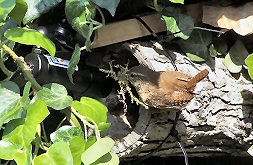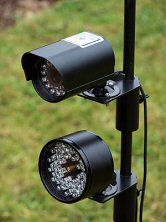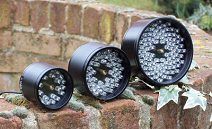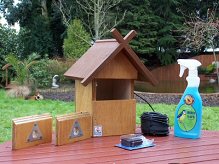Features: Garden wildlife |  |
Watching Garden Wildlife
Okay; so you made the conscious decision to make your garden as wildlife friendly as possible. You've followed the golden rules and provided:
- various sources of food;
- sources of clean water;
- places to hide and shelter;
- places to breed and raise a family.
 So now it's time to sit back and enjoy the fruits of your labour So now it's time to sit back and enjoy the fruits of your labour So now it's time to sit back and enjoy the fruits of your labour. You pick your spot, keeping very still and you wait. Eyes darting from one habitat area to the next, ears learning to filter out the hustle and bustle of the world outside. And sure enough, after a while the little details start to jump out at you. The gentle buzz of a bee bouncing around the roses. The flashing white of the butterflies dancing around the buddleia. So now it's time to sit back and enjoy the fruits of your labour. You pick your spot, keeping very still and you wait. Eyes darting from one habitat area to the next, ears learning to filter out the hustle and bustle of the world outside. And sure enough, after a while the little details start to jump out at you. The gentle buzz of a bee bouncing around the roses. The flashing white of the butterflies dancing around the buddleia.
A faint rustle attracts your attention back to the bush you've been watching intently. A little nose appears twitching and sniffing the air. You smile, complimenting yourself for guessing right. It is a wood mouse (Apodemus sylvaticus) that's been taking the food from the feeding platform you knocked up a couple of weekends ago.
Just as you slowly reposition yourself, helping the blood flow back into your derriere, SPLAT, on your hand. You look up. SPLAT, on your cheek. And as the heavens open you notice a little tail disappearing back under cover. Another typical day in a British garden.
There is another way Watching wildlife in your own garden can be one of the most rewarding pastimes you could encounter and it's there, available twenty four hours a day Watching wildlife in your own garden can be one of the most rewarding pastimes you could encounter and it's there, available twenty four hours a day Watching wildlife in your own garden can be one of the most rewarding pastimes you could encounter and it's there, available twenty four hours a day. Admittedly, it's not as much fun when it's cold, windy, and tipping it down with rain, but there's always something new to see and just knowing that you are helping to keep habitats available for the creatures nearby can't but make you feel happy and content. Watching wildlife in your own garden can be one of the most rewarding pastimes you could encounter and it's there, available twenty four hours a day. Admittedly, it's not as much fun when it's cold, windy, and tipping it down with rain, but there's always something new to see and just knowing that you are helping to keep habitats available for the creatures nearby can't but make you feel happy and content.
 There's no substitute for a good pair of eyes and ears when watching wildlife There's no substitute for a good pair of eyes and ears when watching wildlife There's no substitute for a good pair of eyes and ears when watching wildlife, but sometimes it's either impractical or undesirable to be close enough to get a good view of the action. Binoculars are great, and always handy to have by the garden window, but they're not much help if there are obstructions in the way or it's the middle of the night. You may even put up a small hide in your garden (if you're really keen!) but again, not much fun if it's freezing, damp and cramped. There's no substitute for a good pair of eyes and ears when watching wildlife, but sometimes it's either impractical or undesirable to be close enough to get a good view of the action. Binoculars are great, and always handy to have by the garden window, but they're not much help if there are obstructions in the way or it's the middle of the night. You may even put up a small hide in your garden (if you're really keen!) but again, not much fun if it's freezing, damp and cramped.
 Wren (Troglodytes troglodytes) nesting under the watchful eye of a remote video camera.
There are options though. How many times have you sat in your comfy armchair watching Bill Oddie or Chris Packham on TV narrating enthusiastically over close up images of Blue Tit's feeding their multitude of hatchlings, or hedgehogs and badgers snuffling along the hedgerow looking for worms in the dead of night? There was a time when capturing these types of images was only possible with kit costing thousands of pounds, but, with ever advancing technology Wren (Troglodytes troglodytes) nesting under the watchful eye of a remote video camera.
There are options though. How many times have you sat in your comfy armchair watching Bill Oddie or Chris Packham on TV narrating enthusiastically over close up images of Blue Tit's feeding their multitude of hatchlings, or hedgehogs and badgers snuffling along the hedgerow looking for worms in the dead of night? There was a time when capturing these types of images was only possible with kit costing thousands of pounds, but, with ever advancing technology  it's now relatively easy to capture your own wildlife footage or even create your own wildlife shows it's now relatively easy to capture your own wildlife footage or even create your own wildlife shows it's now relatively easy to capture your own wildlife footage or even create your own wildlife shows (to share with friends and family), with amazing quality, at a fraction of the cost. it's now relatively easy to capture your own wildlife footage or even create your own wildlife shows (to share with friends and family), with amazing quality, at a fraction of the cost.
It was Thomas Jefferson who wrote "All men are created equal", unfortunately, this isn't true when it comes to video cameras, especially for watching wildlife. There are a number of sources from where you can buy all the raw components required to successfully watch and film nature. And, armed with some technical know how, patience and ingenuity it is possible to obtain excellent results.
However, if you are one of the vast majority of casual (or very keen) wildlife watchers who have never picked up a soldering iron in their life, or wouldn't know what an infrared LED was if it poked them in the eye, then there are companies who specialise in offering kits specifically designed for watching all kinds of wildlife.
Whether you are looking for a bird box camera kit or a general wildlife camera kit it's worth considering a few points before you part with your hard earned cash.
The Camera
There are a multitude of cameras available which are potentially suitable for wildlife watching. Broadly speaking, there are two types of technology used. These are CMOS and CCD.
 Camera and lighting unit on stand.
I'm not going to go into all the technical 'geek speak' about the differences between the two technologies; suffice to say that both types of camera have their advantages and disadvantages. CMOS cameras tend to use less power than their CCD equivalent, but CCD cameras tend to offer better picture quality (important I feel if you intend capturing fine detail, particularly when watching small creatures). Camera and lighting unit on stand.
I'm not going to go into all the technical 'geek speak' about the differences between the two technologies; suffice to say that both types of camera have their advantages and disadvantages. CMOS cameras tend to use less power than their CCD equivalent, but CCD cameras tend to offer better picture quality (important I feel if you intend capturing fine detail, particularly when watching small creatures).
The next thing to consider is whether you require a black & white camera or colour. This is a matter of preference on the individuals part and may well come down to what creatures you intend filming and budget constraints, as colour cameras tend to be more expensive.
Most cameras will be fixed focused.  It's worth asking before you buy whether the focus of the camera can be adjusted It's worth asking before you buy whether the focus of the camera can be adjusted It's worth asking before you buy whether the focus of the camera can be adjusted, especially if you intend getting close to very small subjects. It's worth asking before you buy whether the focus of the camera can be adjusted, especially if you intend getting close to very small subjects.
Some suppliers offer variable zoom cameras. These are great for getting that little bit closer to the action and filling the frame.
As it will be exposed to the elements, any camera considered must be weatherproof.
Lighting
Do you intend to watch wildlife at night? If you do than you'll need to consider lighting. Ordinary security flood lights are fine but they tend to be screwed to the wall of the house limiting your viewing area. This is okay if you are lucky enough to attract animals up to your patio doors but not if they're congregating near the cover of bushes at the bottom of the garden. It's worth considering Infrared (IR) lighting. Infrared light is invisible to the human eye (and garden wildlife). It has several advantages and one slight disadvantage. Let's get the disadvantage out of the way first. If you use IR lighting as your sole source of illumination you will only be able to film in black & white, however the lack of colour is a small price to pay considering the benefits.
 Lighting units of various sizes. Lighting units of various sizes.
Some cameras are sensitive to infrared light whilst others are not. Consider what animals you are likely to be watching and at what time of day.
 If you opt for an IR sensitive camera you will need to consider whether you should purchase a camera with separate IR illuminators or, a camera with integrated IR illumination If you opt for an IR sensitive camera you will need to consider whether you should purchase a camera with separate IR illuminators or, a camera with integrated IR illumination If you opt for an IR sensitive camera you will need to consider whether you should purchase a camera with separate IR illuminators or, a camera with integrated IR illumination. Separate IR illuminators offer the opportunity to vary the position of illumination in relation to the direction of the camera but will require separate cabling (for power) and extra brackets/poles for positioning. Integrated IR illumination is a good option too as the overall package is slightly less bulky and quicker to set up. In reality, a combination of a camera with integrated IR and an additional IR Illuminator offers the greatest flexibility. You will always be guaranteed that at least one of your illuminators is pointing in the same direction as the camera but you also have the capability to broaden the illuminated area with the additional illuminator. If you opt for an IR sensitive camera you will need to consider whether you should purchase a camera with separate IR illuminators or, a camera with integrated IR illumination. Separate IR illuminators offer the opportunity to vary the position of illumination in relation to the direction of the camera but will require separate cabling (for power) and extra brackets/poles for positioning. Integrated IR illumination is a good option too as the overall package is slightly less bulky and quicker to set up. In reality, a combination of a camera with integrated IR and an additional IR Illuminator offers the greatest flexibility. You will always be guaranteed that at least one of your illuminators is pointing in the same direction as the camera but you also have the capability to broaden the illuminated area with the additional illuminator.
Consider the size of the area you intend viewing. IR illuminators are available in a number of different powers and are typically offered with ranges from 5m to 25m. It's worth considering using a slightly higher power illuminator than you think you need as this will give you a wider viewing area and a sharper image on your screen.
And finally, as with the camera above, any IR illuminator used must be weatherproof.
Wired or Wireless?
Most wildlife camera kit suppliers will offer a wired or wireless option. In most cases the wired version will be considerably cheaper and is supplied with a single cable containing the video and audio signal as well as a low voltage supply to power the camera and illuminator etc. Typical lengths supplied range from 10 to 35m with various options for extension cables.
Wireless kits have a transmitter built in at the camera end and are either supplied with a battery connector or a DC power extension lead. They also have a small receiver that plugs into your TV. Once connected all you need to do is turn on your TV, switch over to the appropriate channel and wait for the show to start (in theory)! In reality, although they can offer fantastic images, they are heavily affected by any obstructions between the transmitter and receiver.  Claims of wireless ranges of over 50m should be noted with caution Claims of wireless ranges of over 50m should be noted with caution Claims of wireless ranges of over 50m should be noted with caution. Some specialist suppliers do offer kits with an added antenna to help boost reception but you will pay a premium for this. UK law limits the power of RF (radio frequency) transmitters and therefore, in a typical garden, you should expect to achieve good clear images over a range of between 30m and 50m. Claims of wireless ranges of over 50m should be noted with caution. Some specialist suppliers do offer kits with an added antenna to help boost reception but you will pay a premium for this. UK law limits the power of RF (radio frequency) transmitters and therefore, in a typical garden, you should expect to achieve good clear images over a range of between 30m and 50m.
Kit contents Birdbox camera kit contents.
What exactly are you getting for your money? Quality and value for money can vary considerably. As with any major purchase it's worth spending some time researching what's available, comparing specifications and exactly 'what's included' in the price. Birdbox camera kit contents.
What exactly are you getting for your money? Quality and value for money can vary considerably. As with any major purchase it's worth spending some time researching what's available, comparing specifications and exactly 'what's included' in the price.
Much of the time the secret is in the detail (or lack of it in some cases).  Important details such as CCD or CMOS (see camera details above) and length of cable supplied should always be included Important details such as CCD or CMOS (see camera details above) and length of cable supplied should always be included Important details such as CCD or CMOS (see camera details above) and length of cable supplied should always be included. Are any additional connectors likely to be required? (e.g. scart adaptors for connecting to your TV). There's nothing worse than receiving your kit, setting it up outside, coming indoors to connect to your TV only to find the you don't have the right sockets or plugs! Important details such as CCD or CMOS (see camera details above) and length of cable supplied should always be included. Are any additional connectors likely to be required? (e.g. scart adaptors for connecting to your TV). There's nothing worse than receiving your kit, setting it up outside, coming indoors to connect to your TV only to find the you don't have the right sockets or plugs!
Ease of use
Any kit should be quick and easy to set up and maintain. Take a birdbox camera kit for example. In most cases, especially when attracting blue tits (Parus caerulea), it is recommended that boxes be placed at a height of between 2 and 5m. This will require the use of a ladder for most people, so safety must be considered. The fewer tools required to fix the box to the wall or tree, the better. Also, boxes should always be cleaned out at the end of the breeding season to help stop the spread of disease. Will you require tools to remove the roof or front of the box to gain access? Consider the space above the roof of the box, particularly if the roof is your only point of access, as you will have to be able to reach inside and remove the old nesting material.
Value for money
As you shop around you will find quite a difference in pricing with some kits starting from as little as £99 rising to over £500.  Be sure to check the specification and contents of any kit you are interested in to ensure maximum value for money, and remember, just because something is more expensive doesn't automatically make it higher quality Be sure to check the specification and contents of any kit you are interested in to ensure maximum value for money, and remember, just because something is more expensive doesn't automatically make it higher quality Be sure to check the specification and contents of any kit you are interested in to ensure maximum value for money, and remember, just because something is more expensive doesn't automatically make it higher quality. With a little effort and a few minutes searching on the web it's possible to find a wildlife camera kit perfect for your garden and save hundreds of pounds in the process. Be sure to check the specification and contents of any kit you are interested in to ensure maximum value for money, and remember, just because something is more expensive doesn't automatically make it higher quality. With a little effort and a few minutes searching on the web it's possible to find a wildlife camera kit perfect for your garden and save hundreds of pounds in the process.
There's no greater thrill than watching the secret lives of nature's visitors to your garden, and just knowing that your wildlife gardening efforts have helped sustain the wonderful diversity of creatures and habitats that surround us, makes the images you are watching that much more special.
| First published May 2005. | |
Copyright Jason Alexander 2005. Permission is hereby granted for anyone to use this article for non-commercial purposes which are of benefit to the natural environment as long the original author is credited. School pupils, students, teachers and educators are invited to use the article freely. Use for commercial purposes is prohibited unless permission is obtained from the copyright holder. |
Back to home page
Do you live in Merseyside? Interested in its wildlife? |